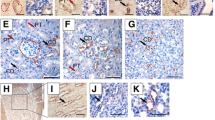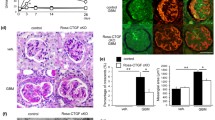Abstract
CCN2 has been shown to be closely involved in the progression of renal fibrosis, indicating the potential of CCN2 inhibition as a therapeutic target. Although the examination of the renal disease phenotypes of adult CCN2 knockout mice has yielded valuable scientific insights, perinatal death has limited studies of CCN2 in vivo. Conditional knockout technology has become widely used to delete genes in the target cell populations or time points using cell-specific Cre recombinase-expressing mice. Therefore, several lines of CCN2-floxed mice have been developed to assess the functional role of CCN2 in adult mice.
CCN2 levels are elevated in renal fibrosis and proliferative glomerulonephritis, making them suitable disease models for assessing the effects of CCN2 deletion on the kidney. Renal fibrosis is characterized by glomerulosclerosis and tubulointerstitial fibrosis and transforming growth factor-β. CCN2 is increased in fibrosis and modulates a number of downstream signaling pathways involved in the fibrogenic properties of TGF-β. Unilateral ureteral obstruction is one of the most widely used models of renal tubulointerstitial fibrosis. In addition, anti-glomerular basement membrane antibody glomerulonephritis has become the most widely used model for evaluating the effect of increased renal CCN2 expression. Herein, we describe the construction of CCN2-floxed mice and inducible systemic CCN2 conditional knockout mice and methods for the operation of unilateral ureteral obstruction and the induction of anti-glomerular basement membrane antibody glomerulonephritis.
Access this chapter
Tax calculation will be finalised at checkout
Purchases are for personal use only
Similar content being viewed by others
References
Ito Y, Aten J, Bende RJ, Oemar BS, Rabelink TJ, Weening JJ, Goldschmeding R (1998) Expression of connective tissue growth factor in human renal fibrosis. Kidney Int 53:853–861
Yokoi H, Mukoyama M, Sugawara A et al (2002) Role of connective tissue growth factor in fibronectin expression and tubulointerstitial fibrosis. Am J Physiol Renal Physiol 282:F933–F942
Kanamoto N, Tagami T, Ueda-Sakane Y et al (2012) Forkhead box A1 (FOXA1) and A2 (FOXA2) oppositely regulate human type 1 iodothyronine deiodinase gene in liver. Endocrinology 153:492–500
Duncan MR, Frazier KS, Abramson S et al (1999) Connective tissue growth factor mediates transforming growth factor β-induced collagen synthesis: down-regulation by cAMP. FASEB J 13:1774–1786
Yokoi H, Mukoyama M, Nagae T et al (2004) Reduction in connective tissue growth factor by antisense treatment ameliorates renal tubulointerstitial fibrosis. J Am Soc Nephrol 15:1430–1440
Adler SG, Schwartz S, Williams ME et al (2010) Phase 1 study of anti-CTGF monoclonal antibody in patients with diabetes and microalbuminuria. Clin J Am Soc Nephrol 5:1420–1428
Falke LL, Dendooven A, Leeuwis JW et al (2012) Hemizygous deletion of CTGF/CCN2 does not suffice to prevent fibrosis of the severely injured kidney. Matrix Biol 31:421–431
Ivkovic S, Yoon BS, Popoff SN et al (2003) Connective tissue growth factor coordinates chondrogenesis and angiogenesis during skeletal development. Development 130:2779–2791
Stricklett PK, Nelson RD, Kohan DE (1999) The Cre/loxP system and gene targeting in the kidney. Am J Physiol Renal Physiol 276:F651–F657
Danielian PS, Muccino D, Rowitch DH et al (1998) Modification of gene activity in mouse embryos in utero by a tamoxifen-inducible form of Cre recombinase. Curr Biol 8:1323–1326
Feil R, Wagner J, Metzger D et al (1997) Regulation of Cre recombinase activity by mutated estrogen receptor ligand-binding domains. Biochem Biophys Res Commun 237:752–757
Toda N, Mori K, Kasahara M et al (2017) Crucial role of mesangial cell-derived connective tissue growth factor in a mouse model of anti-glomerular basement membrane glomerulonephritis. Sci Rep 7:42114
Suganami T, Mukoyama M, Sugawara A et al (2001) Overexpression of brain natriuretic peptide in mice ameliorates immune-mediated renal injury. J Am Soc Nephrol 12:2652–2663
Bonnans C, Chou J, Werb Z (2014) Remodelling the extracellular matrix in development and disease. Nat Rev Mol Cell Biol 15:786–801
Boor P, Ostendorf T, Floege J (2010) Renal fibrosis: novel insights into mechanisms and therapeutic targets. Nat Rev Nephrol 6:643–656
Loeffler I, Wolf G (2014) Transforming growth factor-β and the progression of renal disease. Nephrol Dial Transplant 29(Suppl 1):i37–i45
Farris AB, Colvin RB (2012) Renal interstitial fibrosis: mechanisms and evaluation. Curr Opin Nephrol Hypertens 21:289–300
Isaka Y, Tsujie M, Ando Y et al (2000) Transforming growth factor-β1 antisense oligodeoxynucleotides block interstitial fibrosis in unilateral ureteral obstruction. Kidney Int 58:1885–1892
Cohen AH (1976) Masson’s trichrome stain in the evaluation of renal biopsies. An appraisal. Am J Clin Pathol 65:631–643
Hewitson TD, Smith ER, Samuel CS (2014) Qualitative and quantitative analysis of fibrosis in the kidney. Nephrology (Carlton) 19:721–726
Kok HM, Falke LL, Goldschmeding R et al (2014) Targeting CTGF, EGF and PDGF pathways to prevent progression of kidney disease. Nat Rev Nephrol 10:700–711
Frazier K, Williams S, Kothapalli D et al (1996) Stimulation of fibroblast cell growth, matrix production, and granulation tissue formation by connective tissue growth factor. J Invest Dermatol 107:404–411
Okada H, Kikuta T, Kobayashi T et al (2005) Connective tissue growth factor expressed in tubular epithelium plays a pivotal role in renal fibrogenesis. J Am Soc Nephrol 16:133–143
Guha M, Xu ZG, Tung D et al (2007) Specific down-regulation of connective tissue growth factor attenuates progression of nephropathy in mouse models of type 1 and type 2 diabetes. FASEB J 21(3355–3368):2007
Abreu JG, Ketpura NI, Reversade B et al (2002) Connective-tissue growth factor (CTGF) modulates cell signalling by BMP and TGF-β. Nat Cell Biol 4:599–604
Nguyen TQ, Roestenberg P, van Nieuwenhoven FA et al (2008) CTGF inhibits BMP-7 signaling in diabetic nephropathy. J Am Soc Nephrol 19:2098–2107
Klahr S, Morrissey J (2002) Obstructive nephropathy and renal fibrosis. Am J Physiol Renal Physiol 283:F861–F875
Diamond JR, Kees-Folts D, Ding G et al (1994) Macrophages, monocyte chemoattractant peptide-1, and TGF-β1 in experimental hydronephrosis. Am J Physiol Renal Physiol 266:F926–F933
Diamond JR, van Goor H, Ding G et al (1995) Myofibroblasts in experimental hydronephrosis. Am J Pathol 146:121–129
James LR, Le C, Doherty H et al (2013) Connective tissue growth factor (CTGF) expression modulates response to high glucose. PLoS One 8:e70441
Rayego-Mateos S, Morgado-Pascual JL, Rodrigues-Diez RR et al (2018) Connective tissue growth factor induces renal fibrosis via epidermal growth factor receptor activation. J Pathol 244:227–241
Inoue T, Kusano T, Amano H et al (2019) Cellular communication network factor 2 (CCN2) promotes the progression of acute kidney injury to chronic kidney disease. Biochem Biophys Res Commun 517:96–102
Dwivedi N, Tao S, Jamadar A et al (2020) Epithelial vasopressin type-2 receptors regulate myofibroblasts by a YAP-CCN2-dependent mechanism in polycystic kidney disease. J Am Soc Nephrol 31:1697–1710
Asano T, Niimura F, Pastan I et al (2005) Permanent genetic tagging of podocytes: fate of injured podocytes in a mouse model of glomerular sclerosis. J Am Soc Nephrol 16:2257–2262
Nagashima T, Kim J, Li Q et al (2011) Connective tissue growth factor is required for normal follicle development and ovulation. Mol Endocrinol 25:1740–1759
Gibson DJ, Pi L, Sriram S et al (2014) Conditional knockout of CTGF affects corneal wound healing. Invest Ophthalmol Vis Sci 55:2062–2070
Pi L, Robinson PM, Jorgensen M et al (2015) Connective tissue growth factor and integrin αvβ6: a new pair of regulators critical for ductular reaction and biliary fibrosis in mice. Hepatology 61:678–691
Liu S, Shi-wen X, Abraham DJ et al (2011) CCN2 is required for bleomycin-induced skin fibrosis in mice. Arthritis Rheum 63:239–246
Fontes MS, Kessler EL, van Stuijvenberg L et al (2015) CTGF knockout does not affect cardiac hypertrophy and fibrosis formation upon chronic pressure overload. J Mol Cell Cardiol 88:82–90
Acknowledgments
This work was supported in part by research grants from the Japanese Ministry of Education, Culture, Sports, Science and Technology.
Author information
Authors and Affiliations
Corresponding author
Editor information
Editors and Affiliations
Rights and permissions
Copyright information
© 2023 The Author(s), under exclusive license to Springer Science+Business Media, LLC, part of Springer Nature
About this protocol
Cite this protocol
Yokoi, H., Toda, N., Mukoyama, M. (2023). Generation of Conditional KO Mice of CCN2 and Its Function in the Kidney. In: Takigawa, M. (eds) CCN Proteins. Methods in Molecular Biology, vol 2582. Humana, New York, NY. https://doi.org/10.1007/978-1-0716-2744-0_27
Download citation
DOI: https://doi.org/10.1007/978-1-0716-2744-0_27
Published:
Publisher Name: Humana, New York, NY
Print ISBN: 978-1-0716-2743-3
Online ISBN: 978-1-0716-2744-0
eBook Packages: Springer Protocols




